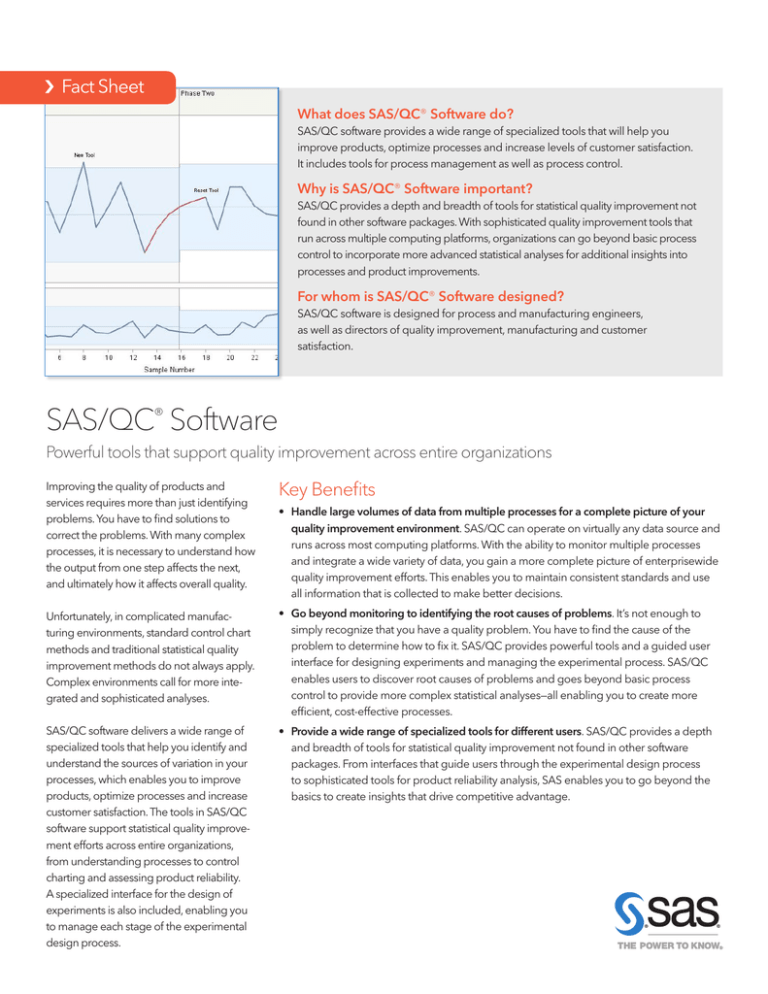
Fact Sheet
What does SAS/QC® Software do?
SAS/QC software provides a wide range of specialized tools that will help you
improve products, optimize processes and increase levels of customer satisfaction.
It includes tools for process management as well as process control.
Why is SAS/QC® Software important?
SAS/QC provides a depth and breadth of tools for statistical quality improvement not
found in other software packages. With sophisticated quality improvement tools that
run across multiple computing platforms, organizations can go beyond basic process
control to incorporate more advanced statistical analyses for additional insights into
processes and product improvements.
For whom is SAS/QC® Software designed?
SAS/QC software is designed for process and manufacturing engineers,
as well as directors of quality improvement, manufacturing and customer
satisfaction.
SAS/QC® Software
Powerful tools that support quality improvement across entire organizations
Improving the quality of products and
services requires more than just identifying
problems. You have to find solutions to
correct the problems. With many complex
processes, it is necessary to understand how
the output from one step affects the next,
and ultimately how it affects overall quality.
Key Benefits
Unfortunately, in complicated manufacturing environments, standard control chart
methods and traditional statistical quality
improvement methods do not always apply.
Complex environments call for more integrated and sophisticated analyses.
• Go beyond monitoring to identifying the root causes of problems. It’s not enough to
simply recognize that you have a quality problem. You have to find the cause of the
problem to determine how to fix it. SAS/QC provides powerful tools and a guided user
interface for designing experiments and managing the experimental process. SAS/QC
enables users to discover root causes of problems and goes beyond basic process
control to provide more complex statistical analyses—all enabling you to create more
efficient, cost-effective processes.
SAS/QC software delivers a wide range of
specialized tools that help you identify and
understand the sources of variation in your
processes, which enables you to improve
products, optimize processes and increase
customer satisfaction. The tools in SAS/QC
software support statistical quality improvement efforts across entire organizations,
from understanding processes to control
charting and assessing product reliability.
A specialized interface for the design of
experiments is also included, enabling you
to manage each stage of the experimental
design process.
• Provide a wide range of specialized tools for different users. SAS/QC provides a depth
and breadth of tools for statistical quality improvement not found in other software
packages. From interfaces that guide users through the experimental design process
to sophisticated tools for product reliability analysis, SAS enables you to go beyond the
basics to create insights that drive competitive advantage.
• Handle large volumes of data from multiple processes for a complete picture of your
quality improvement environment. SAS/QC can operate on virtually any data source and
runs across most computing platforms. With the ability to monitor multiple processes
and integrate a wide variety of data, you gain a more complete picture of enterprisewide
quality improvement efforts. This enables you to maintain consistent standards and use
all information that is collected to make better decisions.
Product Overview
Basic problem solving
SAS/QC software provides extensive statistical quality improvement capabilities. In
addition to running across a variety of platforms, no other software offers such an wide
range of specialized quality improvement
tools. It supports the entire quality improvement process, helping you:
SAS/QC provides procedures for implementing the “basic seven QC tools” for
analyzing data and presenting the results of
problem-solving activities, including check
sheets, Pareto charts, Ishikawa diagrams,
flow diagrams, histograms, scatter plots
and control charts.
• Understand processes.
Statistical process control
• Pinpoint critical problems.
• Establish controls and reduce variation.
• Determine process capabilities.
• Evaluate measurement processes.
• Perform analysis of means.
• Design experiments for improving
products, services and processes.
• Determine product reliability.
There are two main types of tools in SAS/
QC software: point-and-click interfaces and
SAS procedures. The point-and-click interfaces are complete, full-screen oriented
environments for statistical quality improvement applications. The procedures offer
extensive flexibility and greater power than
the interfaces. They require a basic knowledge of the SAS language and the procedure syntax.
Manufacturing engineers concerned with
managing the variability of a process often
use control charts. With control charts, the
natural variability in a manufacturing process
is quantified with a set of control limits. Variations that exceed the limits signal a change
in the process. SAS/QC delivers flexible,
comprehensive tools for implementing
statistical process control. With SAS/QC
software, users can create all commonly
encountered Shewhart charts for variables
and attributes, cumulative sum control charts
and moving average charts.
Process capability analysis
Process capability analysis compares the
distribution of output from an in-control
process to its specification limits to determine the consistency with which the
specification limits can be met. A variety of
graphical displays and statistical measures
are available for comparing the distribution
of an in-control process to its specification
limits. SAS/QC software also provides a
menu-driven interface for standard statistical
quality control applications. It is intended for
quality analysts, quality control managers
and other nonstatisticians. The SQC Menu
System provides a syntax-free environment
for process capability analysis, control charts,
Pareto charts and Ishikawa diagrams.
Reliability analysis
SAS/QC software includes both graphical
and statistical tools for performing reliability analysis for lifetime and repair data.
Users can construct probability plots and
fit life distributions with right- and intervalcensored lifetime data, analyze regression
models and analyze data from repairable
systems. These tools help reliability engineers and industrial statisticians working
with product life data and system repair
data. They also aid workers in other fields,
such as medical research, pharmaceuticals,
social sciences and business, where survival
and recurrence data are analyzed.
GAGE repeatability and
reproducibility
Measurement systems are essential to the
quality of a manufacturing process. The
measurement process itself is subject to
variation, and excessive variation in the
measurement instruments (referred to as
gages) can mask critical variations. One
type of measurement variation is caused
by conditions inherent in the gages. This
variation, known as repeatability, occurs
when one person measures the same
characteristic several times with the same
gage. Another type of measurement variation, known as reproducibility, occurs when
different individuals measure the same
characteristic with the same gage. Other
sources of measurement variation include
part-to-part variation and lack of accuracy,
stability and linearity. SAS/QC provides a
point-and-click interface for assessing gage
The SAS ADX Interface for Design of Experiments lets you analyze fitted models using the
new graphical ANOVA.
repeatability and reproducibility. It provides
range charts and average charts, which
are commonly used in the semiconductor
and automotive industries, as well as more
flexible variance component methods.
The GAGE application is designed for easy
modification to suit local requirements.
Analysis of means
SAS/QC provides a procedure for
conducting an analysis of means. This
procedure provides graphical and statistical methods for determining which treatment group yields the best/worst outcome.
Design of experiments
Many quality-conscious manufacturers are
taking advantage of experimentation to
systematically improve a product or process.
Factorial experimental designs are useful for
studying the effects of various factors on a
response. SAS/QC provides procedures for
generating factorial, fractional factorial and
mixed-level experimental designs.
ADX Interface for Design of
Experiments
Included in SAS/QC software is the ADX
Interface, a point-and-click environment for designing experiments. This is
intended for use primarily by engineers
and researchers who require an interface
for each stage of the experimental design
process, from building designs and determining significant effects to optimization
and reporting. It guides users through
each stage of the process.
Key Features
Basic quality problem solving
• Pareto charts.
• Ishikawa diagrams.
Statistical process control (SPC)
• Shewhart charts: X and R charts, x and x charts, box charts, p charts, np charts, c charts,
u charts, individual measurements and moving range charts, and tests for special causes.
• Cumulative sum control charts.
• Moving average charts.
• Nonstandard control charts:
• Trend charts for time-dependent data.
• Start charts for multivariate process data.
• Multivariate process modeling and monitoring.
• Alternative methods for constructing control limits.
• Westgard rules for laboratory quality control.
GAGE application
• Measurement system evaluation: range charts, average charts and new macros.
• Variance components method.
Process capability analysis
•
•
•
•
•
Comparative histograms.
CDF plots, probability plots, Q-Q plots, P-P plots.
Capability indices.
Confidence, tolerance and prediction intervals.
Descriptive statistics.
Reliability analysis
•
•
•
•
•
•
•
•
•
•
Accelerated life test models for censored data.
Maximum likelihood estimation.
Asymptotic normal and likelihood ratio confidence intervals.
Weibayes analyses.
Nonparametric estimates and confidence intervals.
Analysis of multiple failure models.
Probability plots.
Life vs. stress plots.
Nonparametric plots of mean cumulative function.
Extended set of models and new graphics for recurrent event analysis.
Analysis of means
•
•
•
•
•
Simultaneously compare k treatment means with their overall mean.
Single or multiple response variables.
Compute decision limits from data.
Adjust decision limits for unequal sample sizes.
Means charts, p charts, u charts, box charts.
Design of experiments
• Full and fractional factorial designs.
• D-optimal and A-optimal designs.
• ADX Interface for Design of Experiments:
• Two-level, response surface, mixture and mixed-level designs.
• Split-plot and fractional factorial split plot designs.
• Orthogonal arrays for mixed-level designs.
• Analysis of unstructured experiments.
• Main effect, interaction, cube and factorial plots.
• Statistical analyses including regression, ANOVA, residual and outlier analysis.
• Graphical optimization.
• HTML report generation.
To learn more about SAS/QC
system requirements, download
white papers, view screenshots
and see other related material,
please visit sas.com/qc.
SAS/QC includes a wide range of
graphics and reporting capabilities
to support the entire quality
improvement process.
SAS and all other SAS Institute Inc. product or service names are registered trademarks or trademarks of
SAS Institute Inc. in the USA and other countries. ® indicates USA registration. Other brand and product
names are trademarks of their respective companies. Copyright © 2015, SAS Institute Inc. All rights reserved.
101419_S139206.0715



